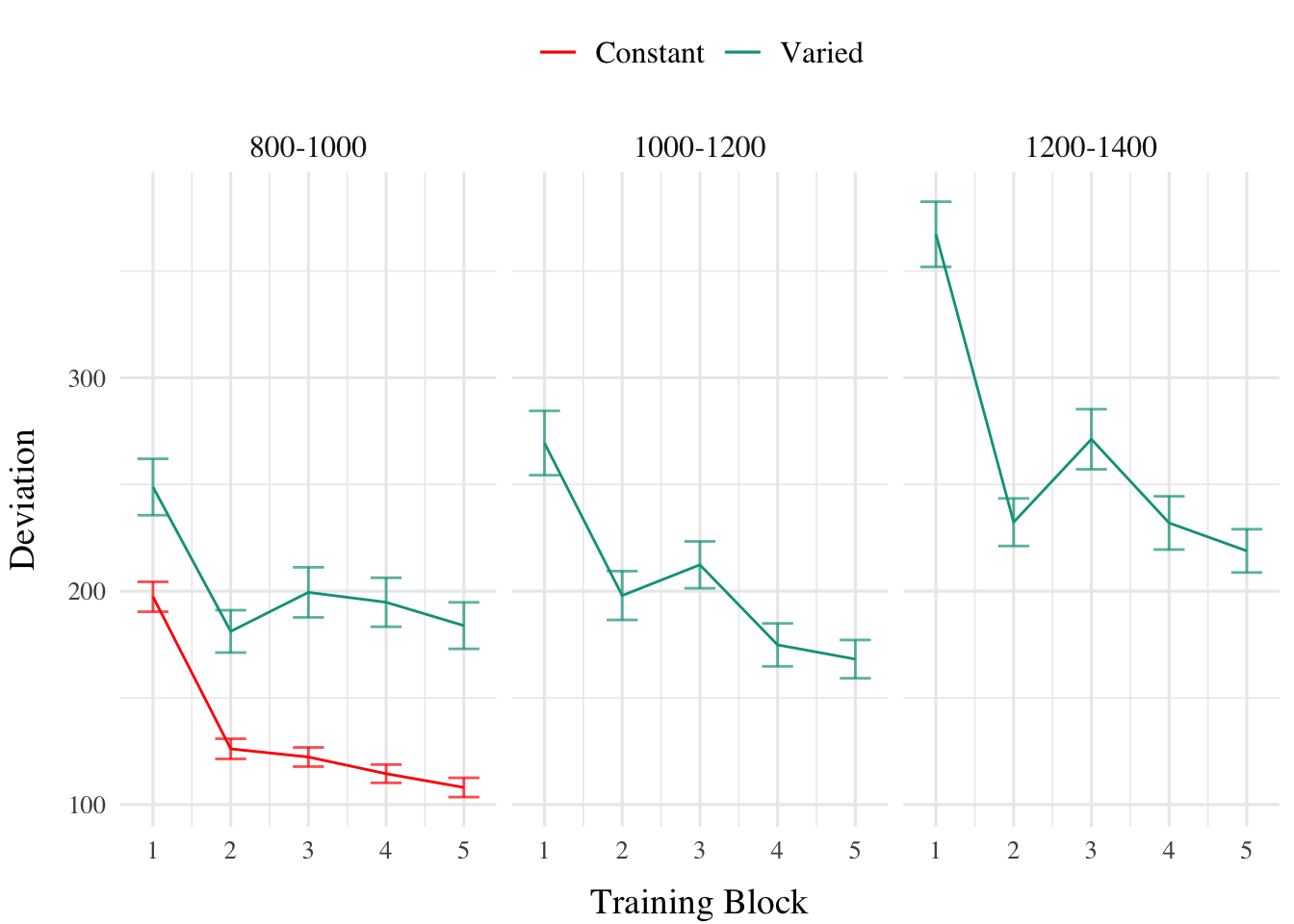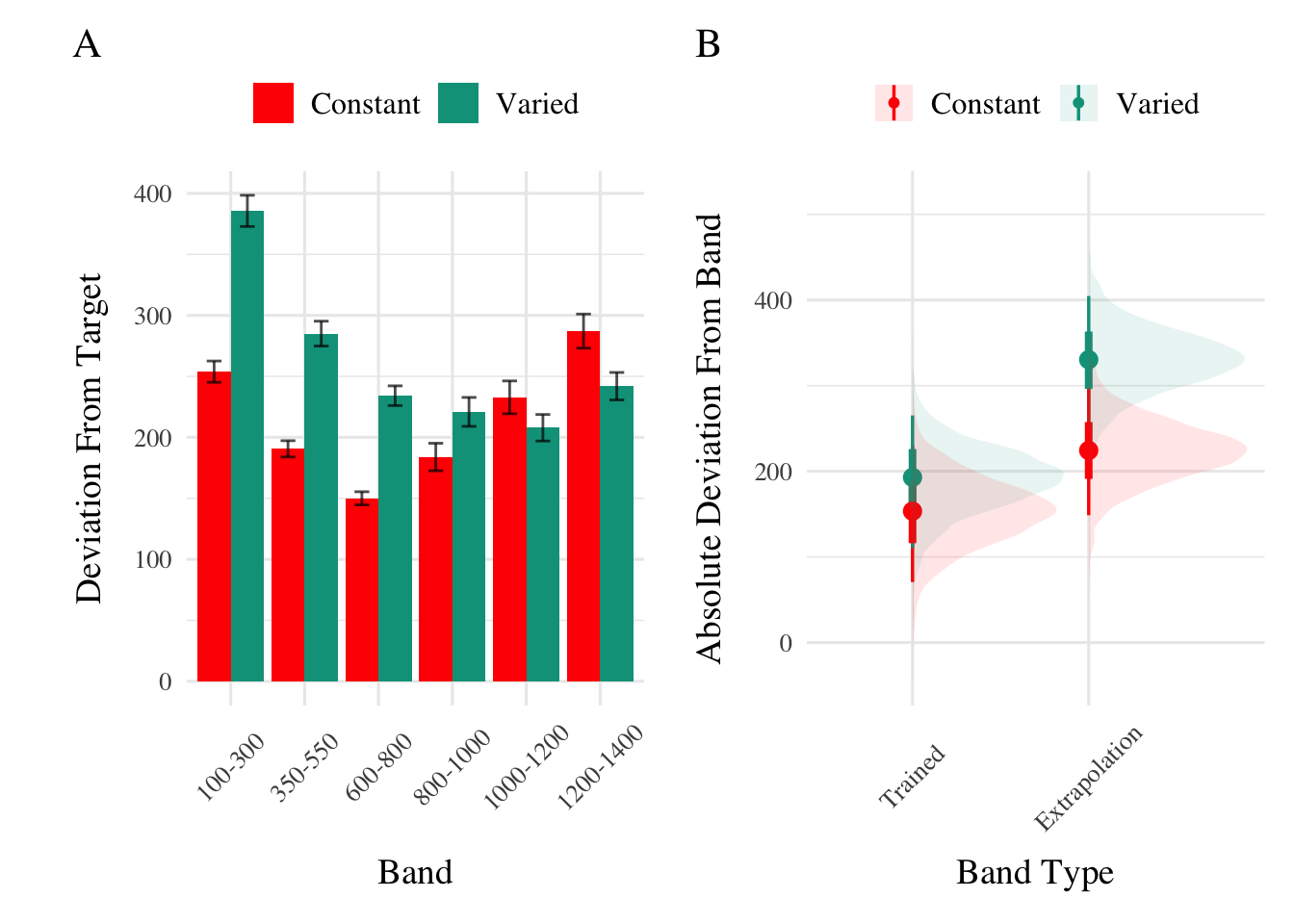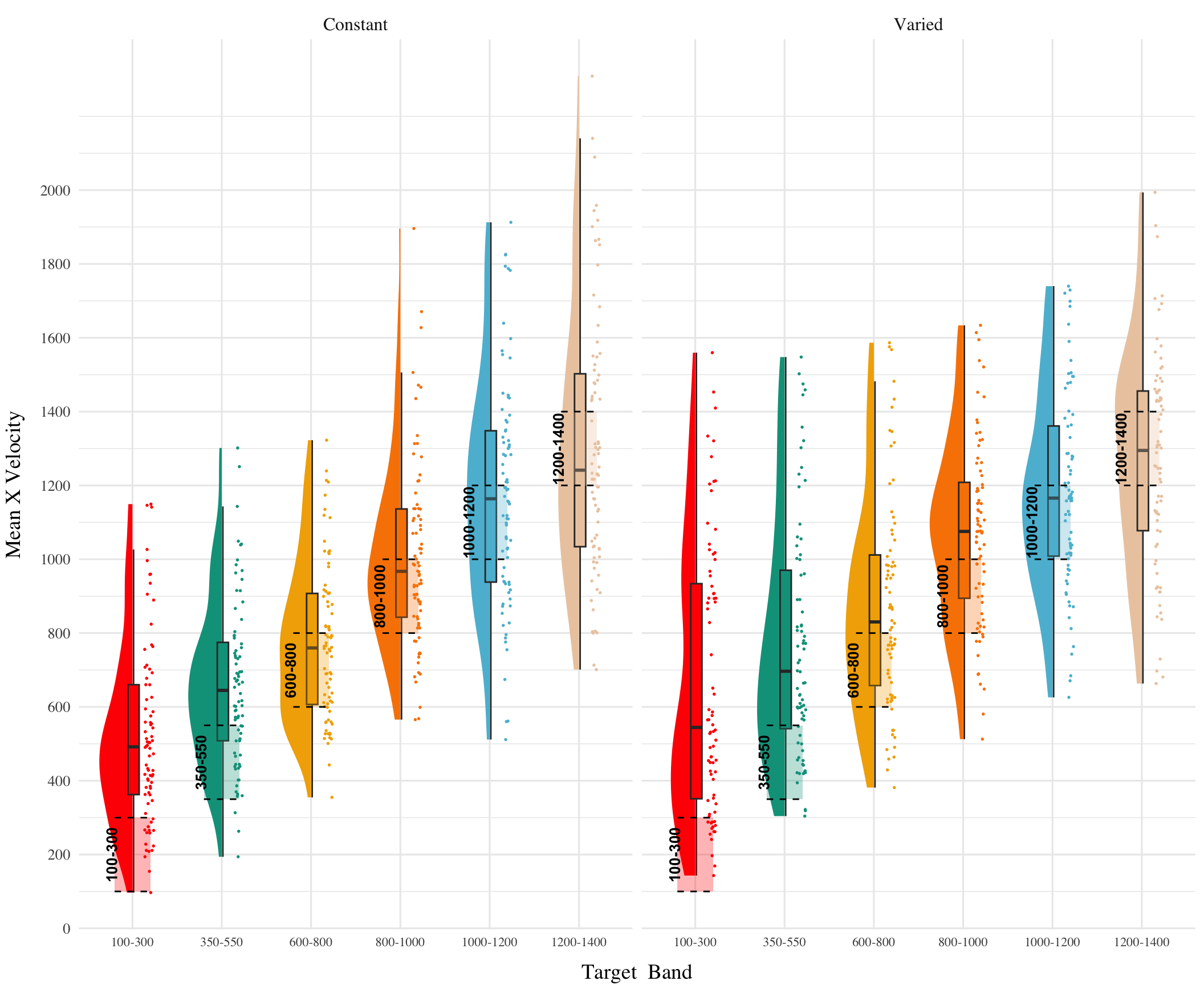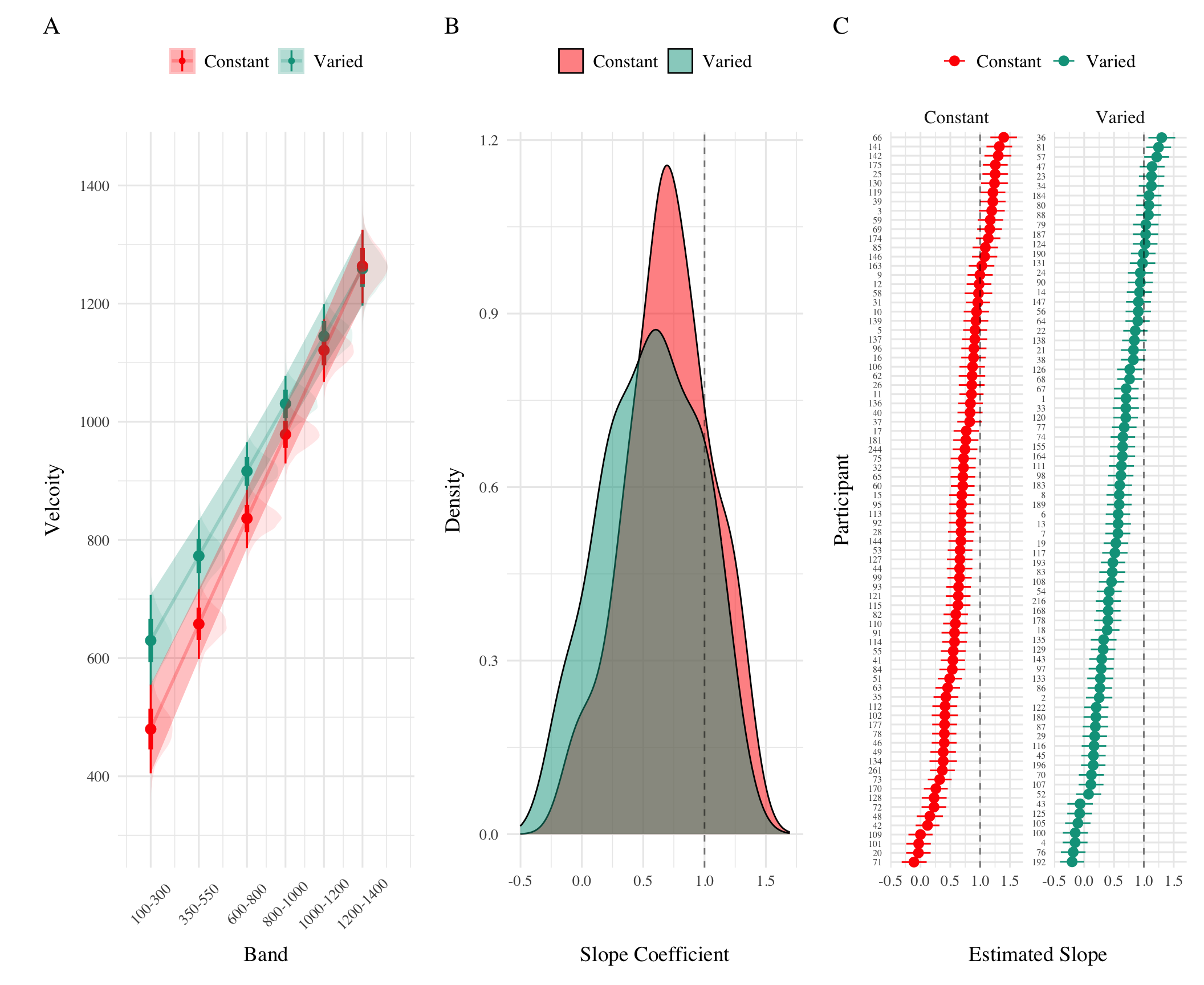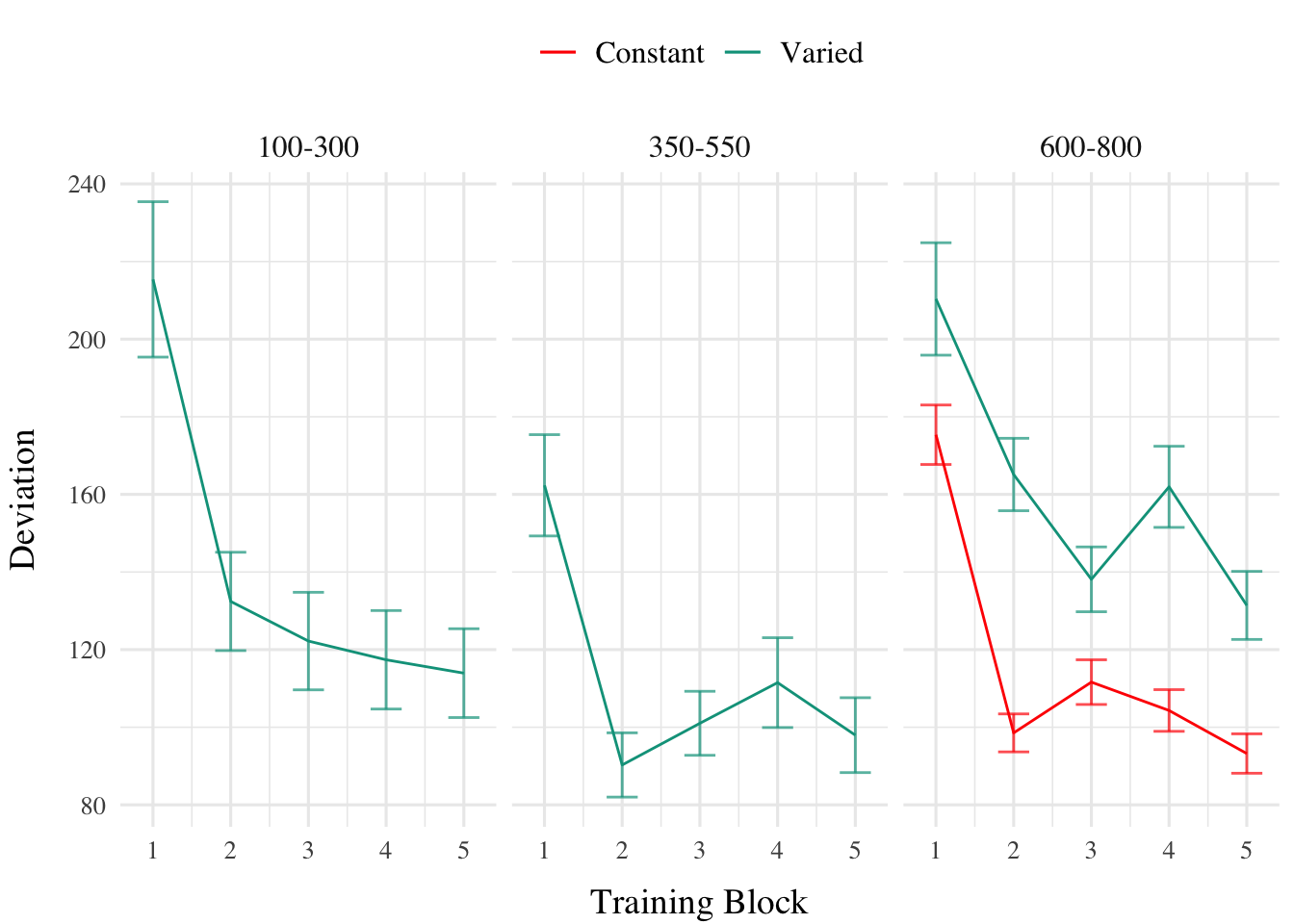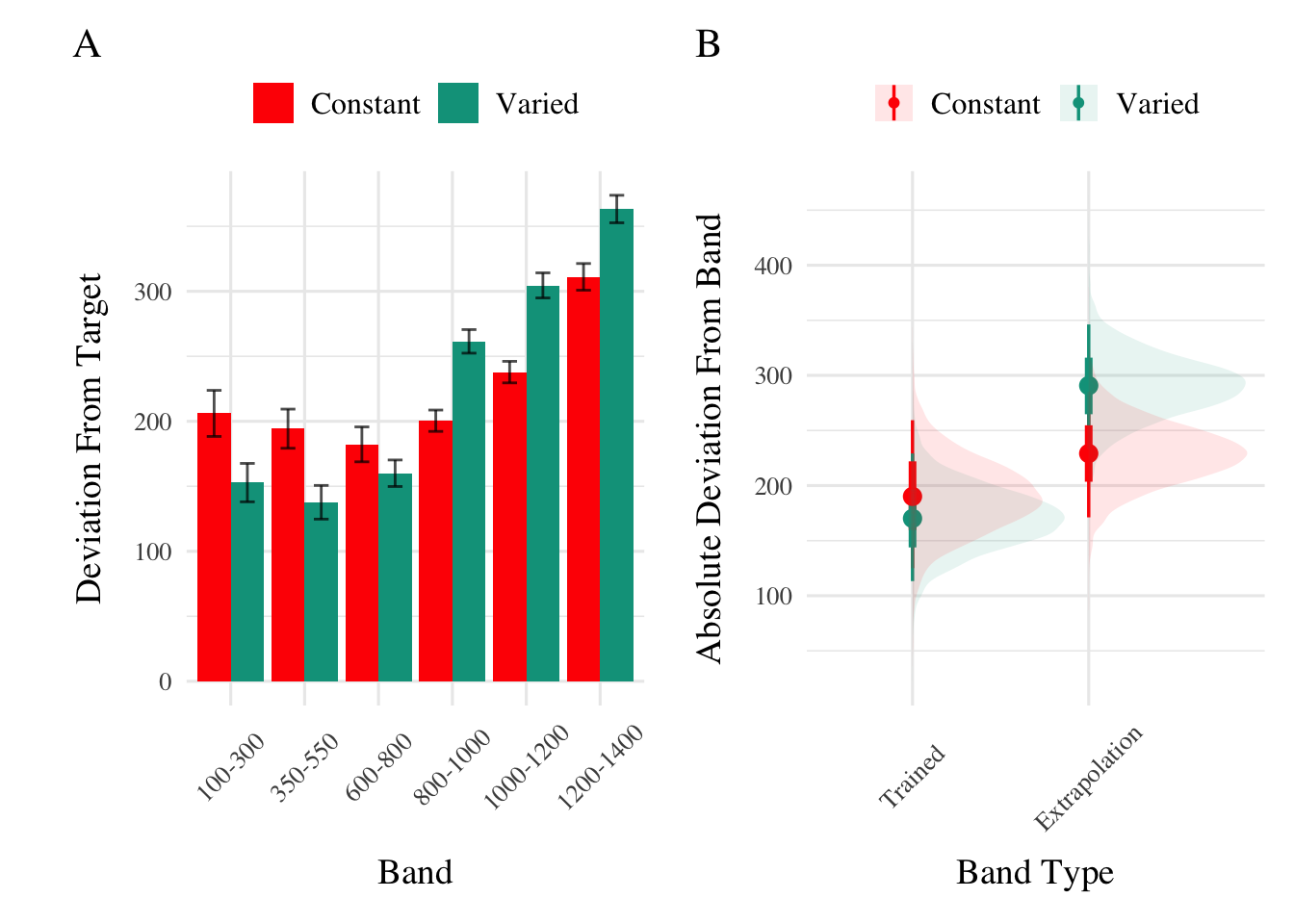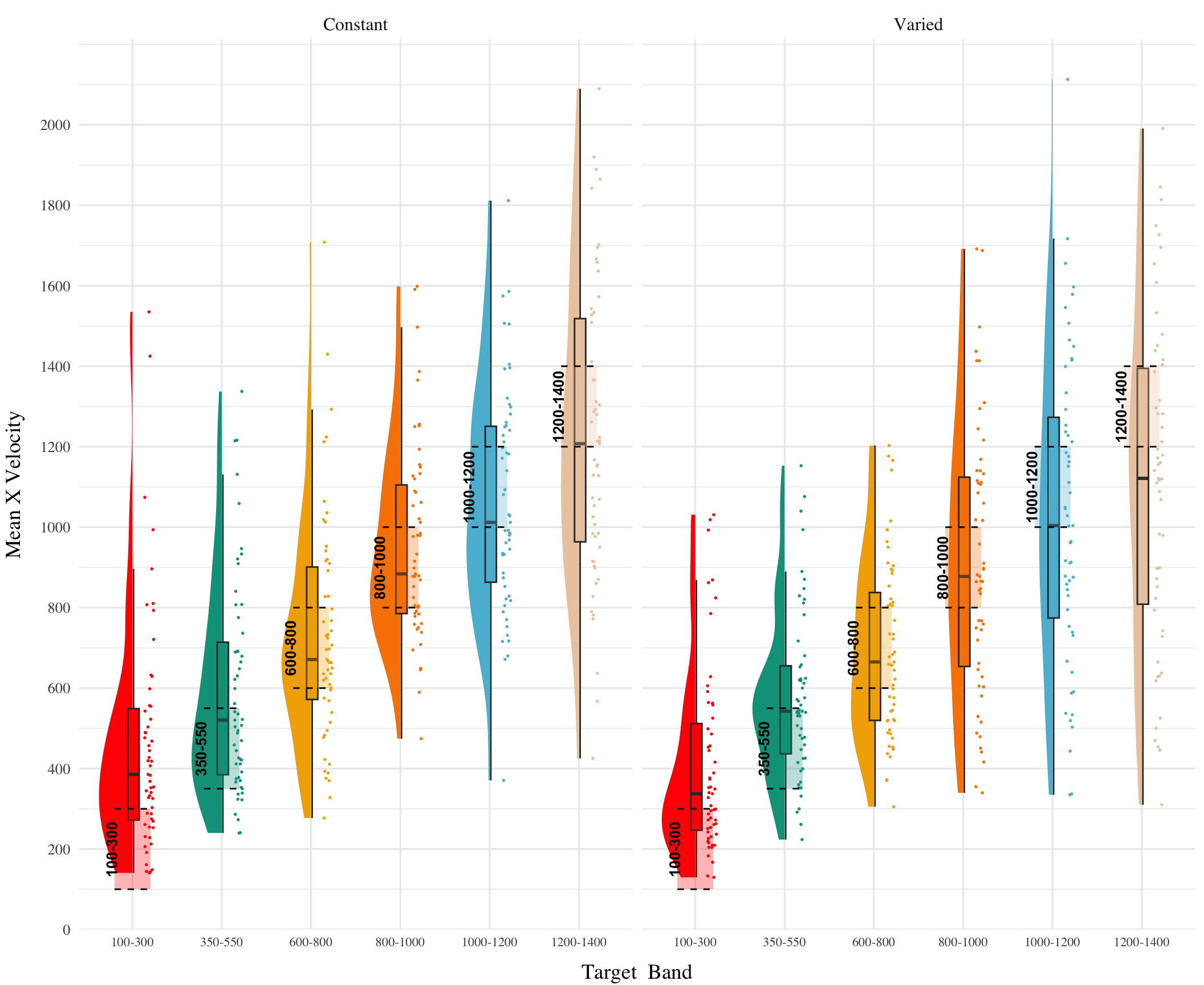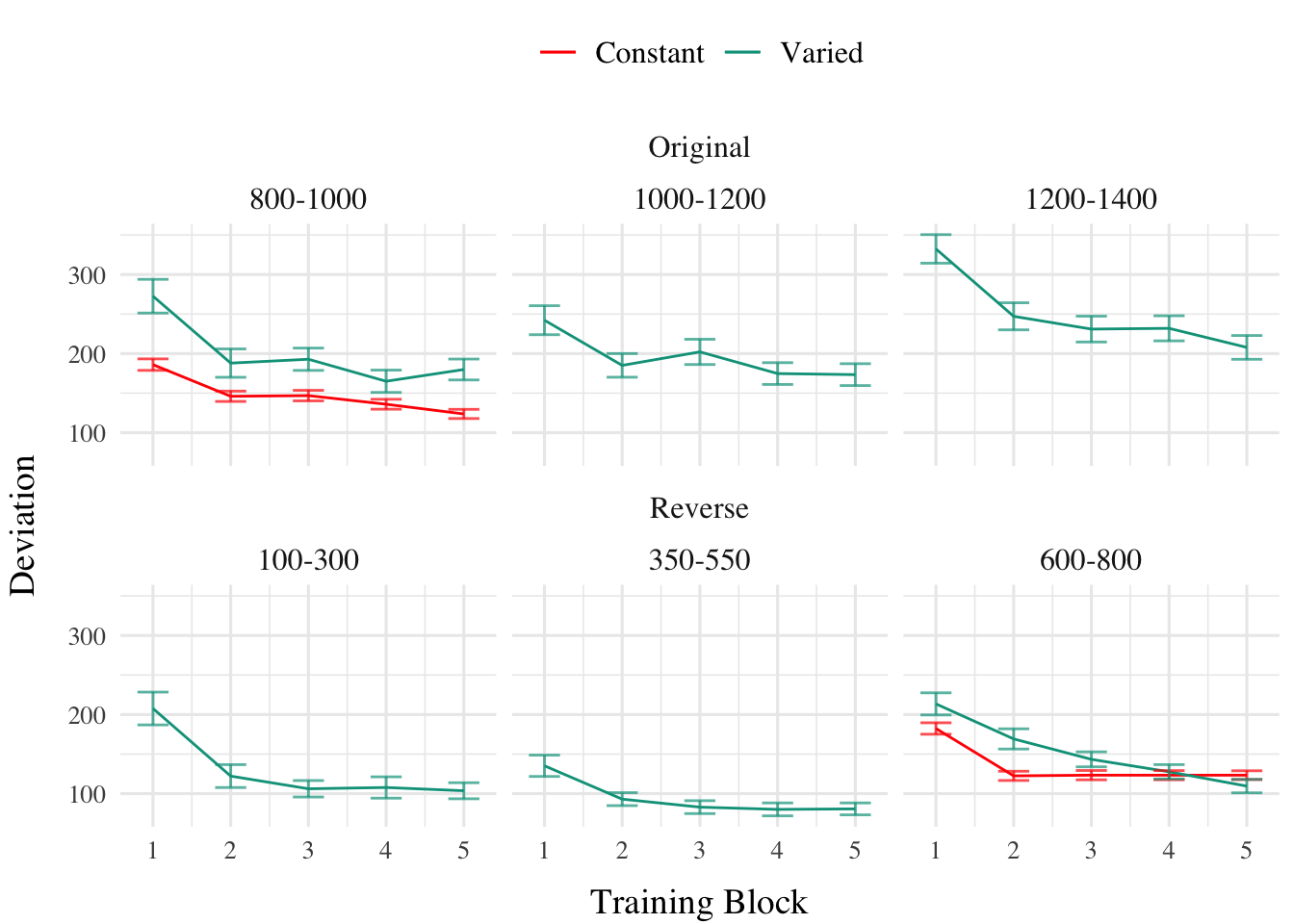Experiment 3
Full
Experiment 1
Analyses Strategy
All data processing and statistical analyses were performed in R version 4.32 Team (2020). To assess differences between groups, we used Bayesian Mixed Effects Regression. Model fitting was performed with the brms package in R Bürkner (2017), and descriptive stats and tables were extracted with the BayestestR package Makowski et al. (2019). Mixed effects regression enables us to take advantage of partial pooling, simultaneously estimating parameters at the individual and group level. Our use of Bayesian, rather than frequentist methods allows us to directly quantify the uncertainty in our parameter estimates, as well as avoiding convergence issues common to the frequentist analogues of our mixed models.
Each model was set to run with 4 chains, 5000 iterations per chain, with the first 2500 discarded as warmup chains. Rhat values were within an acceptable range, with values <=1.02 (see appendix for diagnostic plots). We used uninformative priors for the fixed effects of the model (condition and velocity band), and weakly informative Student T distributions for for the random effects. For each model, we report 1) the mean values of the posterior distribution for the parameters of interest, 2) the lower and upper credible intervals (CrI), and the probability of direction value (pd).
| Group Comparison | Code | Data |
|---|---|---|
| End of Training Accuracy | brm(dist ~ condit) |
Final Training Block |
| Test Accuracy | brm(dist ~ condit * bandType + (1|id) + (1|bandInt) |
All Testing trials |
| Band Discrimination | brm(vx ~ condit * band +(1 + bandInt|id) |
All Testing Trials |
In each experiment we compare varied and constant conditions in terms of 1) accuracy in the final training block; 2) testing accuracy as a function of band type (trained vs. extrapolation bands); 3) extent of discrimination between all six testing bands. We quantified accuracy as the absolute deviation between the response velocity and the nearest boundary of the target band. Thus, when the target band was velocity 600-800, throws of 400, 650, and 900 would result in deviation values of 200, 0, and 100, respectively. The degree of discrimination between bands was index by fitting a linear model predicting the response velocity as a function of the target velocity. Participants who reliably discriminated between velocity bands tended to haves slope values ~1, while participants who made throws irrespective of the current target band would have slopes ~0.
Results
| Term | Estimate | 95% CrI Lower | 95% CrI Upper | pd |
|---|---|---|---|---|
| Intercept | 106.34 | 95.46 | 117.25 | 1 |
| conditVaried | 79.64 | 57.92 | 101.63 | 1 |
Training. Figure 1 displays the average deviations across training blocks for the varied group, which trained on three velocity bands, and the constant group, which trained on one velocity band. To compare the training conditions at the end of training, we analyzed performance on the 800-1000 velocity band, which both groups trained on. The full model results are shown in Table 1. The varied group had a significantly greater deviation than the constant group in the final training block, (\(\beta\) = 79.64, 95% CrI [57.92, 101.63]; pd = 100%).
| Term | Estimate | 95% CrI Lower | 95% CrI Upper | pd |
|---|---|---|---|---|
| Intercept | 152.55 | 70.63 | 229.85 | 1.0 |
| conditVaried | 39.00 | -21.10 | 100.81 | 0.9 |
| bandTypeExtrapolation | 71.51 | 33.24 | 109.60 | 1.0 |
| conditVaried:bandTypeExtrapolation | 66.46 | 32.76 | 99.36 | 1.0 |
Testing. To compare accuracy between groups in the testing stage, we fit a Bayesian mixed effects model predicting deviation from the target band as a function of training condition (varied vs. constant) and band type (trained vs. extrapolation), with random intercepts for participants and bands. The model results are shown in Table 2. The main effect of training condition was not significant (\(\beta\) = 39, 95% CrI [-21.1, 100.81]; pd = 89.93%). The extrapolation testing items had a significantly greater deviation than the training bands (\(\beta\) = 71.51, 95% CrI [33.24, 109.6]; pd = 99.99%). Most importantly, the interaction between training condition and band type was significant (\(\beta\) = 66.46, 95% CrI [32.76, 99.36]; pd = 99.99%), As shown in Figure 2, the varied group had disproportionately larger deviations compared to the constant group in the extrapolation bands.
| Term | Estimate | 95% CrI Lower | 95% CrI Upper | pd |
|---|---|---|---|---|
| Intercept | 408.55 | 327.00 | 490.61 | 1.00 |
| conditVaried | 164.05 | 45.50 | 278.85 | 1.00 |
| Band | 0.71 | 0.62 | 0.80 | 1.00 |
| condit*Band | -0.14 | -0.26 | -0.01 | 0.98 |
Finally, to assess the ability of both conditions to discriminate between velocity bands, we fit a model predicting velocity as a function of training condition and velocity band, with random intercepts and random slopes for each participant. See Table 4 for the full model results. The estimated coefficient for training condition (\(\beta\) = 164.05, 95% CrI [45.5, 278.85], pd = 99.61%) suggests that the varied group tends to produce harder throws than the constant group, but is not in and of itself useful for assessing discrimination. Most relevant to the issue of discrimination is the coefficient on the Band predictor (\(\beta\) = 0.71 95% CrI [0.62, 0.8], pd = 100%). Although the median slope does fall underneath the ideal of value of 1, the fact that the 95% credible interval does not contain 0 provides strong evidence that participants exhibited some discrimination between bands. The estimate for the interaction between slope and condition (\(\beta\) = -0.14, 95% CrI [-0.26, -0.01], pd = 98.39%), suggests that the discrimination was somewhat modulated by training condition, with the varied participants showing less sensitivity between bands than the constant condition. This difference is depicted visually in Figure 3.
E1 Summary
In Experiment 1, we investigated how variability in training influenced participants’ ability learn and extrapolate in a visuomotor task. Our findings that training with variable conditions rresulted in lower final training performance is consistent with much of the prior researchon the influence of training variability (Raviv et al., 2022; Soderstrom & Bjork, 2015), and is particularly unsurprising in the present work, given that the constant group received three times the amount of training on the velocity band common to the two conditions.
More importantly, the varied training group exhibited significantly larger deviations from the target velocity bands during the testing phase, particularly for the extrapolation bands that were not encountered by either condition during training.
Experiment 2
Methods & Procedure
The task and procedure of Experiment 2 was identical to Experiment 1, with the exception that the training and testing bands were reversed (see Figure 4). The Varied group trained on bands 100-300, 350-550, 600-800, and the constant group trained on band 600-800. Both groups were tested from all six bands. A total of 110 participants completed the experiment (Varied: 55, Constant: 55).
Results
| Term | Estimate | 95% CrI Lower | 95% CrI Upper | pd |
|---|---|---|---|---|
| Intercept | 91.01 | 80.67 | 101.26 | 1 |
| conditVaried | 36.15 | 16.35 | 55.67 | 1 |
Training. Figure 5 presents the deviations across training blocks for both constant and varied training groups. We again compared training performance on the band common to both groups (600-800). The full model results are shown in Table 1. The varied group had a significantly greater deviation than the constant group in the final training block, ( \(\beta\) = 36.15, 95% CrI [16.35, 55.67]; pd = 99.95%).
| Term | Estimate | 95% CrI Lower | 95% CrI Upper | pd |
|---|---|---|---|---|
| Intercept | 190.91 | 125.03 | 259.31 | 1.00 |
| conditVaried | -20.58 | -72.94 | 33.08 | 0.78 |
| bandTypeExtrapolation | 38.09 | -6.94 | 83.63 | 0.95 |
| conditVaried:bandTypeExtrapolation | 82.00 | 41.89 | 121.31 | 1.00 |
Testing Accuracy. The analysis of testing accuracy examined deviations from the target band as influenced by training condition (Varied vs. Constant) and band type (training vs. extrapolation bands). The results, summarized in Table 6, reveal no significant main effect of training condition (\(\beta\) = -20.58, 95% CrI [-72.94, 33.08]; pd = 77.81%). However, the interaction between training condition and band type was significant (\(\beta\) = 82, 95% CrI [41.89, 121.31]; pd = 100%), with the varied group showing disproportionately larger deviations compared to the constant group on the extrapolation bands (see Figure 6).
| Term | Estimate | 95% CrI Lower | 95% CrI Upper | pd |
|---|---|---|---|---|
| Intercept | 362.64 | 274.85 | 450.02 | 1.00 |
| conditVaried | -8.56 | -133.97 | 113.98 | 0.55 |
| Band | 0.71 | 0.58 | 0.84 | 1.00 |
| condit*Band | -0.06 | -0.24 | 0.13 | 0.73 |
Testing Discrimination. Finally, to assess the ability of both conditions to discriminate between velocity bands, we fit a model predicting velocity as a function of training condition and velocity band, with random intercepts and random slopes for each participant. The full model results are shown in Table 8. The overall slope on target velocity band predictor was significantly positive, (\(\beta\) = 0.71, 95% CrI [0.58, 0.84]; pd= 100%), indicating that participants exhibited discrimination between bands. The interaction between slope and condition was not significant, (\(\beta\) = -0.06, 95% CrI [-0.24, 0.13]; pd= 72.67%), suggesting that the two conditions did not differ in their ability to discriminate between bands (see Figure 7).
Experiment 2 Summary
Experiment 2 extended the findings of Experiment 1 by examining the effects of training variability on extrapolation performance in a visuomotor function learning task, but with reversed training and testing bands. Similar to Experiment 1, the Varied group exhibited poorer performance during training and testing. However unlike experiment 1, the Varied group did not show a significant difference in discrimination between bands.
Experiment 3
Methods & Procedure
The major adjustment of Experiment 3 is for participants to receive ordinal feedback during training, in contrast to the continuous feedback of the prior experiments. After each training throw, participants are informed whether a throw was too soft, too hard, or correct (i.e. within the target velocity range). All other aspects of the task and design are identical to Experiments 1 and 2. We utilized the order of training and testing bands from both of the prior experiments, thus assigning participants to both an order condition (Original or Reverse) and a training condition (Constant or Varied). Participants were once again recruited from the online Indiana University Introductory Psychology Course pool. Following exclusions, 195 participants were included in the final analysis, n=51 in the Constant-Original condition, n=59 in the Constant-Reverse condition, n=39 in the Varied-Original condition, and n=46 in the Varied-Reverse condition.
Results
| Term | Estimate | 95% CrI Lower | 95% CrI Upper | pd |
|---|---|---|---|---|
| Intercept | 121.86 | 109.24 | 134.60 | 1.00 |
| conditVaried | 64.93 | 36.99 | 90.80 | 1.00 |
| bandOrderReverse | 1.11 | -16.02 | 18.16 | 0.55 |
| conditVaried:bandOrderReverse | -77.02 | -114.16 | -39.61 | 1.00 |
Training. Figure 8 displays the average deviations from the target band across training blocks, and Table 9 shows the results of the Bayesian regression model predicting the deviation from the common band at the end of training (600-800 for reversed order, and 800-1000 for original order conditions). The main effect of training condition is significant, with the varied condition showing larger deviations ( \(\beta\) = 64.93, 95% CrI [36.99, 90.8]; pd = 100%). The main effect of band order is not significant \(\beta\) = 1.11, 95% CrI [-16.02, 18.16]; pd = 55.4%, however the interaction between training condition and band order is significant, with the varied condition showing greater accuracy in the reverse order condition ( \(\beta\) = -77.02, 95% CrI [-114.16, -39.61]; pd = 100%).
| Term | Estimate | 95% CrI Lower | 95% CrI Upper | pd |
|---|---|---|---|---|
| Intercept | 288.65 | 199.45 | 374.07 | 1.00 |
| conditVaried | -40.19 | -104.68 | 23.13 | 0.89 |
| bandTypeExtrapolation | -23.35 | -57.28 | 10.35 | 0.92 |
| bandOrderReverse | -73.72 | -136.69 | -11.07 | 0.99 |
| conditVaried:bandTypeExtrapolation | 52.66 | 14.16 | 90.23 | 1.00 |
| conditVaried:bandOrderReverse | -37.48 | -123.28 | 49.37 | 0.80 |
| bandTypeExtrapolation:bandOrderReverse | 80.69 | 30.01 | 130.93 | 1.00 |
| conditVaried:bandTypeExtrapolation:bandOrderReverse | 30.42 | -21.00 | 81.65 | 0.87 |
Testing Accuracy. Table 10 presents the results of the Bayesian mixed efects model predicting absolute deviation from the target band during the testing stage. There was no significant main effect of training condition,\(\beta\) = -40.19, 95% CrI [-104.68, 23.13]; pd = 89.31%, or band type,\(\beta\) = -23.35, 95% CrI [-57.28, 10.35]; pd = 91.52%. However the effect of band order was significant, with the reverse order condition showing lower deviations, \(\beta\) = -73.72, 95% CrI [-136.69, -11.07]; pd = 98.89%. The interaction between training condition and band type was also significant \(\beta\) = 52.66, 95% CrI [14.16, 90.23]; pd = 99.59%, with the varied condition showing disproprionately large deviations on the extrapolation bands compared to the constant group. There was also a significant interaction between band type and band order, \(\beta\) = 80.69, 95% CrI [30.01, 130.93]; pd = 99.89%, such that the reverse order condition showed larger deviations on the extrapolation bands. No other interactions were significant.
| Term | Estimate | 95% CrI Lower | 95% CrI Upper | pd |
|---|---|---|---|---|
| Intercept | 601.83 | 504.75 | 699.42 | 1.00 |
| conditVaried | 12.18 | -134.94 | 162.78 | 0.56 |
| bandOrderReverse | 13.03 | -123.89 | 144.67 | 0.58 |
| Band | 0.49 | 0.36 | 0.62 | 1.00 |
| conditVaried:bandOrderReverse | -338.15 | -541.44 | -132.58 | 1.00 |
| conditVaried:Band | -0.04 | -0.23 | 0.15 | 0.67 |
| bandOrderReverse:bandInt | -0.10 | -0.27 | 0.08 | 0.86 |
| conditVaried:bandOrderReverse:bandInt | 0.42 | 0.17 | 0.70 | 1.00 |
Testing Discrimination. The full results of the discrimination model are presented in Table 10. For the purposes of assessing group differences in discrimination, only the coefficients including the band variable are of interest. The baseline effect of band represents the slope cofficient for the constant training - original order condition, this effect was significant \(\beta\) = 0.49, 95% CrI [0.36, 0.62]; pd = 100%. Neither of the two way interactions reached significance, \(\beta\) = -0.04, 95% CrI [-0.23, 0.15]; pd = 66.63%, \(\beta\) = -0.1, 95% CrI [-0.27, 0.08]; pd = 86.35%. However, the three way interaction between training condition, band order, and target band was significant, \(\beta\) = 0.42, 95% CrI [0.17, 0.7]; pd = 99.96% - indicating that the varied condition showed a greater slope coefficient on the reverse order bands, compared to the constant condition - this is clearly shown in Figure 10, where the steepness of the best fitting line for the varied-reversed condition is noticably steeper than the other conditions.
Experiment 3 Summary
In Experiment 3, we investigated the effects of training condition (constant vs. varied) and band type (training vs. extrapolation) on participants’ accuracy and discrimination during the testing phase. Unlike the previous experiments, participants received ordinal feedback during the training phase. Additionally, Experiment 3 included both the original order condition from Experiment 1 and the reverse order condition from Experiment 2. The results revealed no significant main effects of training condition on testing accuracy, nor was there a significant difference between groups in band discrimination. However, we observed a significant three-way interaction for the discrimination analysis, indicating that the varied condition showed a steeper slope coefficient on the reverse order bands compared to the constant condition. This result suggests that varied training enhanced participants’ ability to discriminate between velocity bands, but only when the band order was reversed during testing.
Results Summary
Overall Summary of Experiments 1-3
Across three experiments, we investigated the impact of training variability on learning and extrapolation in a visuomotor function learning task.
In Experiment 1, participants in the varied training condition, who experienced a wider range of velocity bands during training, showed lower accuracy at the end of training compared to those in the constant training condition. Crucially, during the testing phase, the varied group exhibited significantly larger deviations from the target velocity bands, particularly for the extrapolation bands that were not encountered during training. The varied group also showed less discrimination between velocity bands, as evidenced by shallower slopes when predicting response velocity from target velocity band.
Experiment 2 extended these findings by reversing the order of the training and testing bands. Similar to Experiment 1, the varied group demonstrated poorer performance during both training and testing phases. However, unlike Experiment 1, the varied group did not show a significant difference in discrimination between bands compared to the constant group.
In Experiment 3, we provided only ordinal feedback during training, in contrast to the continuous feedback provided in the previous experiments. Participants were assigned to both an order condition (original or reverse) and a training condition (constant or varied). The varied condition showed larger deviations at the end of training, consistent with the previous experiments. Interestingly, there was a significant interaction between training condition and band order, with the varied condition showing greater accuracy in the reverse order condition. During testing, the varied group once again exhibited larger deviations, particularly for the extrapolation bands. The reverse order conditions showed smaller deviations compared to the original order conditions. Discrimination between velocity bands was poorer for the varied group in the original order condition, but not in the reverse order condition.
